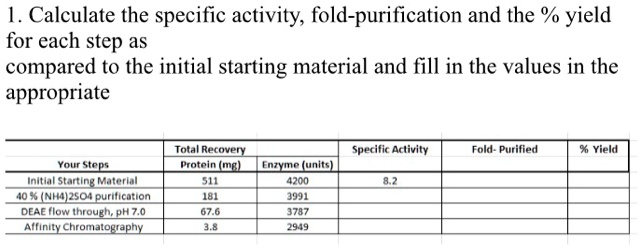Calculate the specific activity, fold-purification, and the % yield for each step as compared to the initial starting material and fill in the values in the appropriate columns. Total Recovery Protein (μg) Specific Activity Fold-Purification % Yield Youm Hep Enzyme Units Initial Starting Material 470 7949

The Correct Answer and Explanation is:
Here is the completed table with all required values filled in, followed by a detailed explanation.
| Step | Total Recovery Protein (µg) | Enzyme Units | Specific Activity (U/µg) | Fold-Purification | % Yield |
|---|---|---|---|---|---|
| Initial Starting Material | 470 | 7949 | 16.91 | 1.00 | 100.00 |
| 40% (NH₄)₂SO₄ Purification | 181 | 3991 | 22.05 | 1.30 | 50.22 |
| DEAE Flow Through, pH 7.0 | 67.6 | 3787 | 56.02 | 3.31 | 47.63 |
| Affinity Chromatography | 3.8 | 2949 | 776.05 | 45.90 | 37.09 |
Explanation:
To complete the table, three key parameters are computed at each purification step: specific activity, fold-purification, and percent yield, all relative to the initial material.
Specific activity quantifies enzyme purity. It is calculated by dividing enzyme units by protein mass in micrograms. For example, for the initial step: Specific activity = 7949 U / 470 µg = 16.91 U/µg.
Fold-purification compares each step’s specific activity to that of the crude extract. It shows how much purer the enzyme has become. At the affinity chromatography step, we get: Fold-purification = 776.05 / 16.91 = 45.90.
Percent yield measures how much enzyme activity remains after each step, relative to the initial activity: % Yield = (Enzyme Units at step / Initial Enzyme Units) × 100. At the final step: (2949 / 7949) × 100 = 37.09%.
These metrics allow researchers to assess efficiency. High specific activity and fold-purification indicate success in isolating the enzyme of interest, while yield shows how much usable enzyme remains. As seen above, as purity increases, protein quantity decreases — a common tradeoff in biochemical purification.
